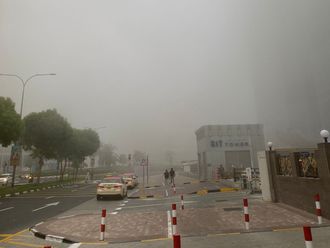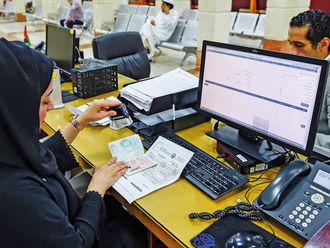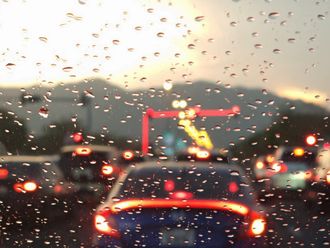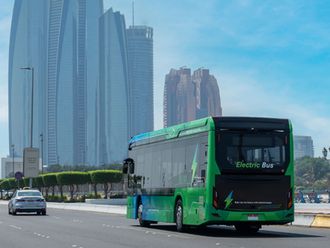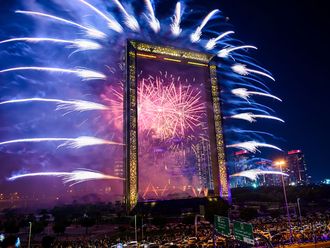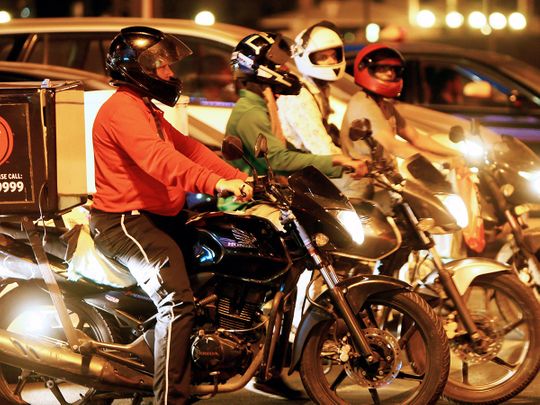
Abu Dhabi: Delivery service providers in the UAE have become an inseparable part of the country’s service landscape, with hundreds of employees plying the roadways — mostly on two-wheelers — to make products available to residents.
While deliveries by laundries, groceries and restuarants have always been a ubiquitous part of life in the UAE, the tremendous growth in delivery services through e-commerce over the past few years now makes all kinds of products and services available at the doorstep of UAE residents.
Amid this tremendous growth, it has become imperative to keep delivery riders safe and also to ensure the safety of other road users. Traffic and safety authorities have, therefore, introduced a number of safety standards to be followed by riders, rider agencies and operator platforms. These latest measures include standards for delivery bike boxes and their measures, announced by Abu Dhabi Police earlier this month. Other requirements were released last year, while in Dubai, Roads and Transport Authority (RTA) released a safety manual in the summer of 2021 that outlines comprehensive safety measures.
These measures focus on deliveries carried out on bikes — mainly meals from restaurants and cafes that are delivered by riders employed with British online food ordering company Deliveroo, or its Kuwait-originated equivalent, Talabat. Other kinds of deliveries, which are not transported on two-wheelers, are governed by regular rules governing vehicular and freight traffic.
Traffic authorities have also called upon residents to report violations. So here is a look at all the regulations that guide delivery riders in the UAE.
Abu Dhabi
A joint committee that includes Abu Dhabi Police, the Department of Municipalities and Transport’s Integrated Transport Centre, and the Department of Health, regulates delivery rider safety in the emirate. The Joint Committee for Traffic Safety issues regulations and carries out rider awareness sessions.
At a briefing late last year, the committee said the new regulations were essential in light of recent fatalities: A total of 13 motorbike delivery rider fatalities were recorded in Abu Dhabi in 2020, up from nine fatalities in 2019.
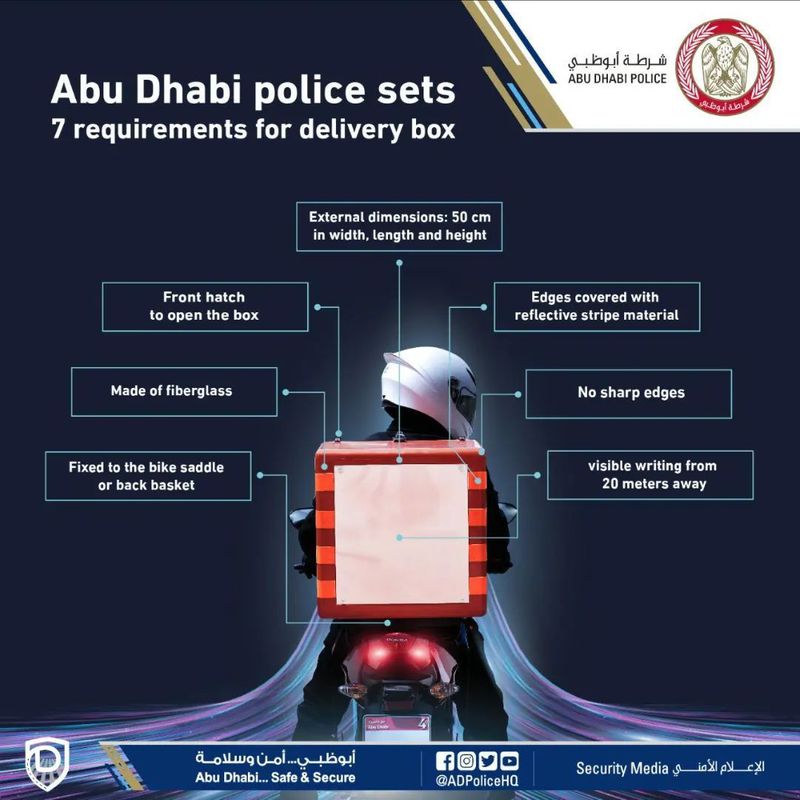
The committee accordingly issued the following regulations, with more to follow:
— Delivery riders must abide by all traffic regulations and avoid illegal behaviours that can endanger themselves as well as other road users.
— Delivery riders must avoid speeding at all times.
— Riders must stick to their lanes and avoid overtaking. The failure to indicate when overtaking and sudden veering after changing lanes, have been cited as the primary causes of motorcycle accidents. So riders must avoid such practises.
— Companies must provide riders with personal protective equipment, such as helmets, footwear and heat-protective and reflective clothing suitable for motorcyclists, which must be worn by the riders when on the job.
— The head and tail lights of bikes should be functional.
— Riders must also avoid riding during periods of bad weather.
— Riders must avoid parking on pedestrian crossings and at entrances to and exits from buildings and villas.
Abu Dhabi Police additionally issued the following stipulations for delivery bike boxes:
— The boxes must be a maximum of 50 centimetres in length, height and width.
— The edges of the box must be covered with reflective stripes to ensure that the box is visible to motorists.
— The box should not have any sharp corners.
— There should be a front hatch that allows for the box to be opened.
— The box must be made of fiberglass.
— The box must be attached securely to the rear basket or seat.
— There should be clear labels or texts on the front of the box that are visible from a distance of at least 20 metres.
Dubai
Dubai’s Roads and Transport Authority (RTA) launched the Activity Manual for Managing and Providing Delivery Services in July 2021, with comprehensive requirements for riders, rider gear and delivery boxes.
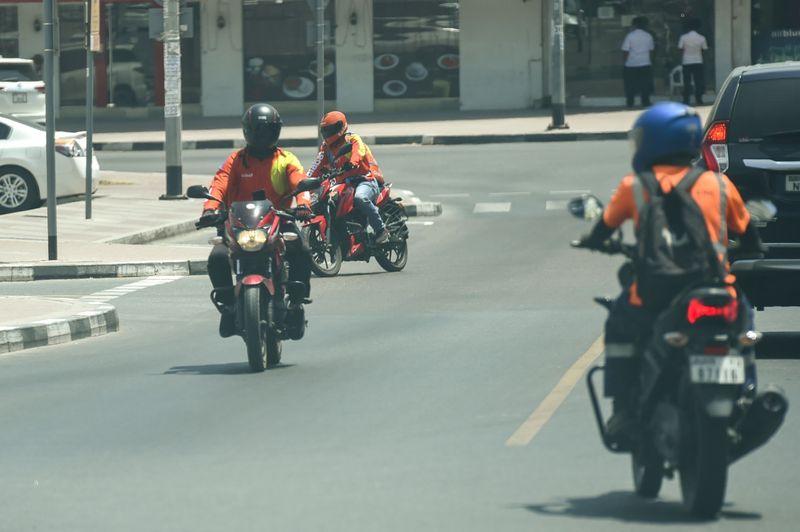
Delivery boxes
-Bike boxes must be a maximum of 50 centimetres in length, width and height. This ensures that the box does not obscure the rider’s side and rear view.
-The box must be securely attached to the rear basket or seat of the motorbike.
-It should consist of rounded edges without sharp corners, and must not be made of wood or metal.
-All corners of the box must be covered with a reflective phosphorescent tape that shows the name of the company or service provider on the back side of the box, or according to the advertisement approved by the RTA.
-The rear extension of the box should not exceed the motorbike frame, provided that they are at the same level as the maximum level.
-The box must be replaced with a new one with the same specifications every two years.
-The bike box must always be kept clean.
-The box should comply with the food safety requirements of Dubai Municipality in the event of food delivery.
Rider uniforms
-Rider uniforms must include long-sleeved shirt or blouse, trousers with reflective stripes, pockets on the sides, safety shoes, gloves, winter jacket with the company logo, long tapered pants and cooling towel to reduce heat.
Shirt: The long-sleeved shirt or blouse should have padded elbows to provide cushioning and protection in the event of a driver falling. If padding is not available on the shirt itself, then the driver must wear protective gear on the knees and elbows.
Safety shoes: These must be fully covered, without visible strings. No slippers or sandals are allowed.
Protective helmet: These must be durable and of high quality. They should cover the entire head, and bear the mark of one of the international standards: European standard ECE 22.05, or American standard FMVSS 218 DOT, or standard “SNILL” helmet. The helmet must be completely covered. The glass (barrier) must feature one of the approved international standard brands, in order to protect the eyes from dust and objects. Scratched or inappropriate eye protectors that may limit visibility, reflect the lights when driving, especially in bright sunlight and/or dark times, are not accepted (gray and white colours).
Jackets and pants: They must be of high quality and conform to one of the following international standards: EN ISO 20471: 2013 (Europe / ISO) ANSI / ISEA 107-2015 (USA) AS / NZS 4602.1: 2011 (Australia)
Gloves: They are necessary to reduce the vibration of the motorbike in the driver’s hands. They provide the required protection and flexibility for the hands.
Long tapered pants: These trousers should not be wide-legged, and must be made of material that reduces the impact of high temperature.
Cooling towel: These should be made available to help riders reduce the effect of sweating.
Fines
The RTA manual also includes a series of fines for noncompliant riders or operators.
-Failing to wear the specific uniform designed for delivery vehicle drivers, or failure to maintain good appearance: Dh100, Dh150, or Dh200
-Driving the delivery vehicle into an opposite direction, or reversing it in a dangerous way, or obstructing the traffic: Dh100, Dh150, or Dh200
-Driving recklessly in a way that poses a threat to other road users, speeding, or overtaking another vehicle in a dangerous manner: Dh200, Dh300, or Dh400
-Exceeding the delivery vehicle speed by more than 100 kilometres per hour on the roads where the speed limit is 100 kilometres per hour or more—Dh300, Dh200, Dh400
-Failing to comply with the rules and regulations of traffic and roads, general safety and health while driving, including failing to wear personal protective equipment like helmet, gloves, reflective jacket: Dh700, Dh500, or permit suspension
-Using a bike box that does not meet technical requirements and specifications: Dh500, Dh700, or permit suspension
-Allowing pillion riding during the delivery: Dh500, Dh700, or permit suspension
-Using the left lane of the road, or failing to keep to the motorbike lane: Dh500, Dh700, or permit suspension
-Using a backpack to deliver orders: Dh500, Dh700, or permit suspension
-Sitting in an immodest or uncivilised way: Dh200
-Carrying out deliveries for companies unlicensed by RTA, or engaging in delivery activities with unlicensed companies: Dh5,000, or suspension of the establishment permit
-Sticking ads or materials on the delivery bikes without obtaining the RTA permit, including the display of unauthorised stickers, logos, flags or symbols: Dh5,000
-Failing to comply with service operation hours, or providing services during prohibited hours: Dh1000, or Dh2000
-Failing to provide safety and security equipment: Dh500 for each vehicle
-Failing to equip the motorbike with a delivery box in compliance with the food safety and security requirements by Dubai Municipality: Dh500 for each vehicle
-Failing to meet the technical specifications for the delivery box, including the location of installation of the box approved by the licensing agency: Dh500 for each vehicle
-Failing to limit the speed within 100 kilometres per hour: Dh2,000
-Failing to keep the vehicle or the delivery box clean: Dh200
-Failing to install or fix the delivery box safely and securely: Dh300
-Failing to install a mobile holder on the bike to allow for handsfree use for of map services: Dh300



